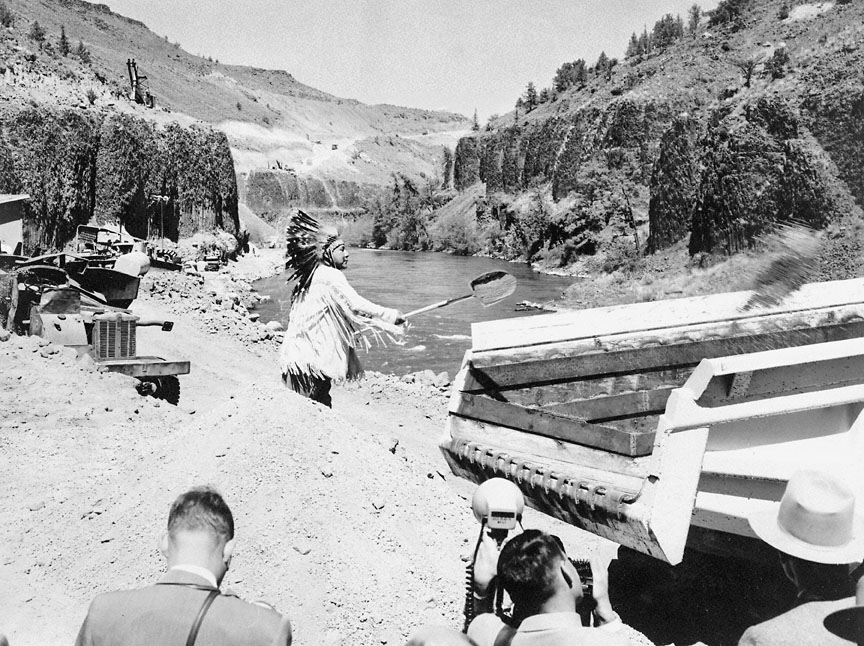- Catalog No. —
- CN 000299
- Date —
- May 2, 1956
- Era —
- 1950-1980 (New Economy, Civil Rights, and Environmentalism)
- Themes —
- Environment and Natural Resources, Native Americans
- Credits —
- Oregon Historical Society, Oregon Historical Quarterly
- Regions —
- Central Columbia River
- Author —
- Les Orderman, Oregon Journal
Chief Joseph McCorkle Breaks Ground, Pelton Dam
This Les Orderman photograph of Wasco Chief Joseph McCorkle symbolically breaking ground for the Pelton Dam was originally published in the Oregon Journal, on May 2, 1956, in conjunction with an article, “Pelton Dam Rite Held,” written by Walt Mattilla. Work on the dam actually began on April 18, 1956.
From 1949 through 1956, the Pelton Dam project, planned by Portland General Electric (PGE), was hotly contested—largely due to the negative effects the dam would have upon the Deschutes River’s anadromous fish populations. As the public debated the pros and cons of the Pelton Dam, much attention was given to the competing needs of fish and electric-power consumers, but much less attention was paid to the Indians of the Warm Springs Reservation, whose leadership was eagerly awaiting the approval of the project.
Because the Pelton Dam and resulting reservoir were sited along the eastern boundary of the Confederated Tribes of the Warm Springs Reservation, tribal leaders expected financial compensation amounting to approximately $85,000 per year from PGE in return for the tribes’ permission to move forward with the project. Early state opposition to the project not only threatened the loss of potential income for roughly 1,200 enrolled members of the confederated tribes, but was also viewed as an affront to the tribes’ treaty rights of 1855. According to the treaty, the “middle tribes of Oregon” had reserved “the exclusive right of taking fish in the streams running through and bordering said reservation.” In a hearing before the Federal Power Commission (FPC) in June 1951, tribal attorney T. Leland Brown, interpreted the treaty language to mean that the Warm Springs tribes “have exclusive rights to all the fish in the Deschutes and Metolius rivers where they border the reservation. We deny that the fish commission has any rights on those streams without our approval.”
The tribe began receiving annual payments from PGE in 1958, and in 1964, with the completion of the Round Butte Dam, PGE increased their compensation to $220,000 per year. Additionally, the tribes secured the sole right to sell fishing permits to visitors of the two reservoirs. In 1982, the Warm Springs tribes constructed a 19-megawatt powerhouse at the Pelton project’s reregulating dam to generate more revenue, and in 2002 they assumed one-third ownership of the project.
Further Reading:
Wollner, Craig. Electrifying Eden: Portland General Electric, 1889–1965. Portland, Ore., 1990.
Hunt, Jack. “Land Tenure and Economic Development on the Warm Springs Reservation.” Journal of the West 9, 1970: 93–109.
Written by Joshua Binus, © Oregon Historical Society, 2004.
